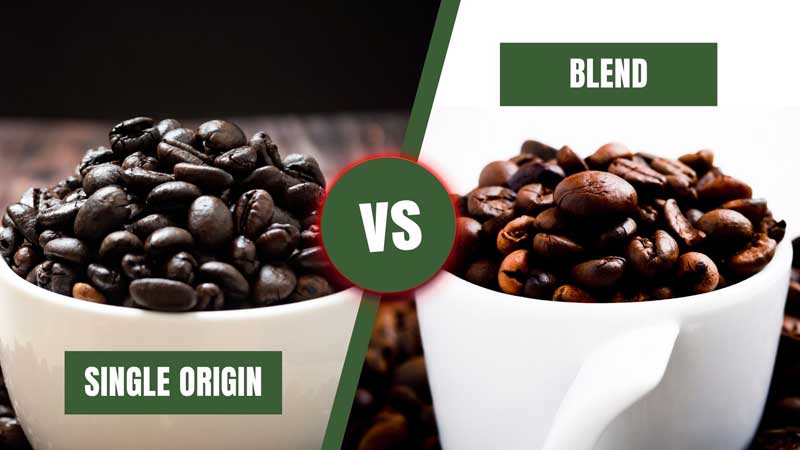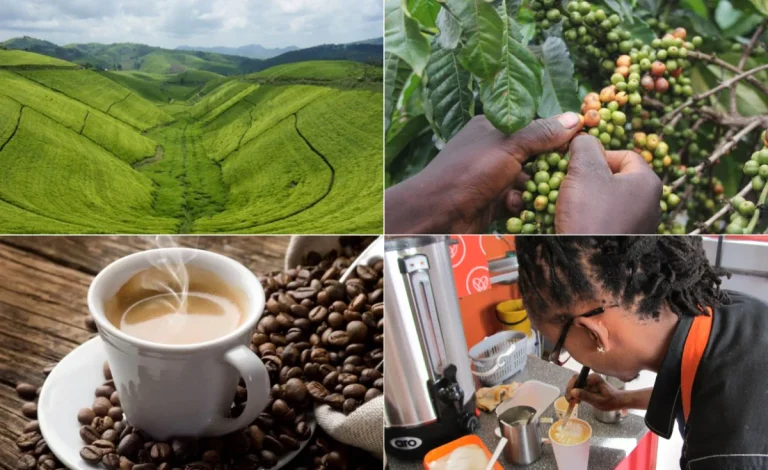If you’re a coffee lover looking to enhance your knowledge and appreciation for the beverage, this article is for you.
We explore the world of coffee through the lens of single-origin versus blended beans. By examining the distinguishing characteristics and taste comparison between the two, we help you navigate the complexities of coffee choices.
Delve into the impact of roast levels on flavor profiles and gain insights on choosing the right roast for your palate. We discuss the various factors affecting coffee taste, including bean varieties and roasting techniques.
Explore sustainability and health considerations surrounding coffee consumption, addressing environmental impact, health benefits, and debunking myths. Join us on this coffee journey as we decode the mystique of coffee tastes.
Key Takeaways:
- Single-origin coffee offers unique and distinct flavors, while blends provide a well-balanced and consistent taste.
- The roast level of coffee greatly affects its flavor, with lighter roasts highlighting the coffee’s origin and darker roasts bringing out more caramelized and roasted flavors.
- Factors such as bean varieties and roasting techniques play a significant role in the taste of coffee, making it important to consider these factors when choosing your morning brew.
Introduction
Coffee, a beloved beverage enjoyed worldwide, comes in a variety of forms, from single-origin beans to expertly crafted blends, each offering a unique flavor profile and story behind its origin.
Coffee beans, the seeds of the coffee plant, are at the heart of this aromatic elixir. The journey of these beans from cultivation to your cup is a fascinating one. Roasting methods play a crucial role in bringing out the nuanced flavors hidden within the beans. Roasting can range from light to dark, each imparting different notes, be it the fruity acidity of a light roast or the deep caramel undertones of a dark roast.
Single-origin coffees are esteemed for their purity, expressing the distinct terroir of a particular region. On the other hand, blended coffees are carefully crafted to harmonize flavors, offering a balanced and complex taste. Exploring the world of coffee is a delightful pursuit, where every cup tells a tale of craftsmanship and passion.
Single-Origin Coffee vs. Blends
Single-origin coffee and blends represent two distinct approaches to coffee production and flavor composition, each offering a unique taste experience influenced by their sourcing and roasting methods.
Distinguishing Characteristics
The distinguishing characteristics of single-origin coffee and blends lie in their source regions, flavor nuances, and the meticulous blending or separation of beans to achieve specific taste profiles.
Single-origin coffees are prized for their distinct terroir, reflecting the unique climate, soil composition, and altitude of the region where they are grown. This results in unparalleled flavor complexities, such as fruity notes from Ethiopian beans or chocolatey undertones from Colombian varieties.
On the other hand, coffee blends offer a harmonious fusion of beans from multiple origins, carefully curated to create a balanced and flavorful cup. Blending allows roasters to experiment with different beans’ characteristics, producing a rich and multidimensional taste experience.
Taste Comparison
When comparing the taste of single-origin coffee to blends, one can discern subtle differences in flavor intensity, acidity levels, and the overall complexity of the flavor profiles created through different roasting and blending techniques.
Single-origin coffees are sourced from a specific region, allowing the unique characteristics of that location’s soil and climate to shine through in the cup. This results in distinct flavors such as fruity notes, floral undertones, or earthy richness. On the other hand, blends combine beans from multiple origins to achieve a balanced and consistent taste. Blends often aim to harmonize different flavor profiles, balancing acidity with bitterness and enhancing the overall aroma.
The acidity in coffee refers to its brightness and sharpness, akin to the zest of citrus fruits. Single-origin coffees tend to showcase acidity that is specific to their terroir, such as a crisp apple-like acidity in Ethiopian beans or a bright, vibrant acidity in Kenyan varieties. Conversely, blends may exhibit a more rounded acidity, achieved through a mix of beans with varying levels of acidity, resulting in a smoother, well-rounded taste.
Bitterness, a common element in coffee, can differ in intensity between single-origin and blended coffees. Single-origin beans may have a more pronounced bitterness, especially in dark roasts, as the inherent flavors of the beans are often accentuated. Blends, on the other hand, can balance bitterness with sweetness from different bean components, resulting in a more nuanced and layered taste profile.
Aroma plays a crucial role in the overall coffee experience. Single-origin coffees typically offer distinct aromas that reflect their unique growing conditions, such as floral, fruity, or spicy notes. Blends, with their combination of beans, may present a more complex aroma profile, blending different fragrance notes to create a well-rounded olfactory experience.
Decoding Roast Levels
Understanding the various roast levels in coffee is essential for unlocking the full spectrum of flavors inherent in Arabica and Robusta beans, influencing the final taste and aroma of the brewed beverage.
In terms of coffee roast levels, the process can significantly impact the taste, aroma, and overall experience of your cup of joe. For instance, a lighter roast, such as City roast, preserves the bean’s original characteristics, highlighting its acidity and floral notes, while a dark roast like French roast tends to bring out bolder, smokier flavors with less acidity. This transformation occurs due to the chemical changes that the beans undergo during the roasting process, affecting their color, oiliness, and ultimately, the flavor profile they develop.
Impact on Flavor
Roast levels play a pivotal role in shaping the flavor profile of coffee, influencing the aroma, acidity, and overall taste experience based on the degree of roasting applied to the beans.
When coffee beans are roasted to a light level, the result is often a more pronounced acidity along with floral and fruit notes. Moving up the roast spectrum to a medium level enhances the sweetness and body of the coffee, balancing the acidity and introducing hints of caramel or chocolate undertones. Dark roasts, on the other hand, bring out bold, smoky flavors with reduced acidity and a fuller-bodied profile, sometimes even exhibiting bitter notes.
Roasting intensities not only alter the taste but also influence the aroma, with light roasts offering bright, lively scents, while dark roasts emit rich, earthy aromas.
Choosing the Right Roast
Selecting the right roast for your coffee preferences involves considering the desired flavor profile, taste preferences, and brewing method to ensure a satisfying and personalized coffee experience tailored to your palate.
In terms of coffee roasting, each level brings out different characteristics in the beans, influencing the final cup. For those who enjoy a bright and acidic brew, opt for a light roast that showcases the bean’s origin flavors. Medium roasts offer a balance between acidity and body, making them versatile for various brewing methods. Dark roasts, on the other hand, bring out rich, bold flavors with a hint of smokiness, perfect for espresso or French press. Experimenting with different roast levels allows you to discover your ideal match based on your preferred taste notes and brewing style.
Factors Affecting Coffee Taste
The taste of coffee is influenced by a multitude of factors, including the bean varieties used, the roasting techniques applied, and the unique flavor profiles that emerge from the interaction of these elements.
Bean Varieties
Coffee taste is heavily influenced by the choice of bean varieties, with Arabica and Robusta being the most prominent species known for their distinct flavor profiles, growing conditions, and caffeine content.
Arabica beans are considered to offer a smoother, more complex flavor with hints of sweetness, acidity, and floral notes, making them highly prized among coffee connoisseurs. On the other hand, Robusta beans are known for their bold, earthy flavor, often described as stronger and more bitter than Arabica beans.
The taste of coffee can also be significantly affected by the region where the beans are cultivated. Factors such as altitude, soil quality, and climate play a crucial role in influencing the nuances of flavor in the final brew, showcasing the remarkable impact of growing conditions on the taste of coffee beans.
Roasting Techniques
Roasting techniques play a crucial role in defining the flavor profiles of coffee, as varying roast levels, durations, and methods can enhance or diminish the inherent taste nuances of the beans.
In terms of coffee roasting, the intricacies lie in the skillful manipulation of time, temperature, and technique to unlock the beans’ full potential. Roast level determines the color and flavor intensity of the final product. Light roasts preserve the bean’s natural flavors, showcasing their origin characteristics, while dark roasts bring out bold, smoky notes through caramelization. The duration of roasting affects the beans’ internal structure, influencing the release of oils and sugars that contribute to the overall taste. Different roasting methods, such as drum roasting or air roasting, impart distinct flavor nuances, making the process both an art and a science in perfecting the desired taste.
Sustainability and Health Considerations
The sustainability and health aspects of coffee production are crucial considerations, encompassing environmental impact, ethical sourcing practices, and the potential health benefits associated with consuming this beloved beverage.
Environmental Impact
The environmental impact of coffee production is a critical focus area, with initiatives such as Fair Trade and Rainforest Alliance certifications aiming to mitigate environmental harm and promote sustainable practices across the coffee industry.
These certification programs play a vital role in ensuring that coffee is produced in an environmentally responsible manner, supporting the well-being of both the planet and the communities involved in cultivation. Sustainability efforts are also being made by coffee producers to reduce water usage, decrease carbon emissions, and protect biodiversity.
By implementing environmentally friendly practices, these initiatives are helping to minimize the negative effects of coffee production on ecosystems and wildlife. The commitment to coffee sustainability is driving positive change within the industry and encouraging consumers to make more informed choices when selecting their brew.
Health Benefits and Myths
Coffee consumption is associated with a range of potential health benefits, dispelling common myths and misconceptions while exploring the organic options available for health-conscious coffee enthusiasts.
Research suggests that coffee is not only a delicious beverage but also packed with antioxidants that may help protect against chronic diseases such as heart disease and type 2 diabetes. Individuals who drink organic coffee can benefit from avoiding harmful chemicals used in conventional coffee production. Despite the belief that coffee can lead to dehydration, moderate consumption is unlikely to cause significant dehydration as previously thought.
Conclusion
Coffee is not just a beverage but a cultural experience that blends diverse flavors, sustainability considerations, and health aspects into each aromatic cup, inviting coffee lovers to savor every sip with newfound appreciation.
From the rich and bold notes of dark roast to the fruity and acidic tones of light roast, the taste spectrum of coffee is vast and varied, catering to a myriad of preferences. The coffee industry has been increasingly moving towards sustainable practices, with many coffee producers focusing on environmentally friendly cultivation methods and fair trade initiatives to support local communities. On the health front, coffee has been associated with various benefits, such as improved cognitive function, enhanced physical performance, and a reduced risk of certain diseases, making it not only a delightful indulgence but also a potentially healthful choice.
Frequently Asked Questions
What is the difference between single-origin and blended coffee?
Single-origin refers to coffee that comes from a specific geographic region, farm, or even a single plot of land. Blended coffee, on the other hand, is a mix of different beans from various origins.
Does the origin of coffee affect its taste?
Yes, the origin of coffee can greatly influence its taste. Factors such as soil, climate, and processing methods in different regions can result in unique flavors and aromas in the coffee beans.
What are the benefits of drinking single-origin coffee?
Single-origin coffee allows you to experience the unique flavors and characteristics of a specific region or farm. It also supports small-scale farmers and promotes sustainable practices in the coffee industry.
Why do some coffee roasters prefer blends over single-origin beans?
Blends offer more consistency in taste as roasters can combine different beans to achieve a desired flavor profile. They also tend to be more cost-effective than single-origin beans.
How can I determine if a coffee is single-origin or a blend?
Look for information on the packaging or ask your barista for details. Single-origin coffee is typically labeled with the specific region or farm it comes from, while blends may have a mix of different origins listed.
Does single-origin coffee always taste better than blends?
Not necessarily. It ultimately comes down to personal preference and the quality of the beans and roasting process. Some people may prefer the complexity of blended coffee, while others may enjoy the distinct flavors of single-origin beans.






